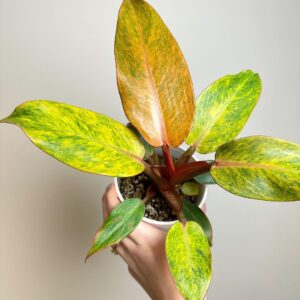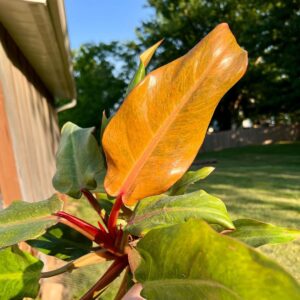Follow this Philodendron Orange Marmalade Care and Growing Guide for thriving plants in your home with vibrant leaves.
If you want to add some bright colors to your plant collection, then check this Philodendron Orange Marmalade Care and Growing Guide.
Learn Growing Strawberry Shake Philodendron
Philodendron Orange Marmalade Profile

The Philodendron Orange Marmalade belongs to the Araceae family, also known as the Aroid family. This tropical plant originates from the rainforests of South America and is cherished by plant enthusiasts for its stunning appearance and unique characteristics.
With its vibrant foliage, the ‘Orange Marmalade’ easily catches the eye of other houseplants. Its large, heart-shaped leaves display a captivating combination of orange, yellow, and green colors, resembling the hues of delicious marmalade. The leaves have a glossy texture, adding an extra touch of elegance to their allure.
The Philodendron Orange Marmalade can change the color of its leaves depending on the amount of light it receives. When exposed to bright indirect light, the leaves showcase vibrant orange and yellow tones. In lower light conditions, the foliage may turn green as it adjusts to its environment.
Read Philodendron Fuzzy Petiole Growing and Care Guide
Propagating Philodendron Orange Marmalade from Cuttings
Here’s a step-by-step guide on how to propagate this plant:
1. Choose a stem from the parent plant that is mature and free from any signs of disease or damage. Look for a stem that has at least two to three nodes.
2. Using a clean pair of sharp scissors or pruning shears, make a clean cut just below a node on the selected stem.
3. Ideally, the cutting should be around 4 to 6 inches in length.
4. Trim off the lower leaves of the cutting, leaving only a few leaves at the top intact.
5. Apply rooting hormone (optional).
6. Fill a small pot or container with a well-draining potting mix.
7. Make a small hole in the planting medium with your finger or a pencil and gently insert the cut end of the stem into the hole
8. Place the potted cutting in a warm and humid environment with bright, indirect light. Do not keep the cuttings in direct sun.
9. Keep the soil slightly moist but not overly saturated. Avoid overwatering, as it can lead to rotting.
10. Mist the cutting and the surrounding environment regularly to increase humidity. You can also cover the cutting with a clear plastic bag or place it in a propagator to create a mini greenhouse effect.
11. Once the cutting has developed a healthy root system, you can carefully transplant it into a larger pot filled with a well-draining potting mix.
Read Gryphon Begonia Growing and Care Information
Best Pot for Philodendron Orange Marmalade

When selecting a pot for your Philodendron Orange Marmalade, you should consider the plant’s growth habits and requirements. To ensure optimum growth, you should choose a pot that accommodates the current root system of your philodendron plant. Young plants typically thrive in a pot with a diameter of 4-6 inches (10-15 cm).
As your plant matures, you should gradually repot it into a pot that is one size bigger than the old one, taking into account its spread.
Read Everything About Growing Alocasia Jacklyn
Philodendron Orange Marmalade Care and Growing Guide

Sunlight
Philodendron Orange Marmalade thrives in bright, indirect sunlight. You should place it near a window with filtered light or in a spot where it receives gentle, indirect sunlight throughout the day.
To prevent scorching the leaves, you should avoid exposing the plant to direct sunlight. It’s best to find a location with consistent, moderate light levels to maintain the plant’s vibrant foliage.
Soil
Use well-draining soil for Philodendron Orange Marmalade. You can achieve this by using a mixture of peat moss, perlite, and a high-quality potting mix. This combination effectively retains moisture without waterlogging the roots.
Watering
Thoroughly water your Philodendron Orange Marmalade when you feel that the top inch (2.5 cm) of soil is dry to the touch. Make sure that any excess water drains out of the pot, as this plant prefers slightly moist but not soggy conditions.
To prevent root rot, avoid overwatering. Adjust the frequency of watering based on environmental conditions and the moisture requirements of the plant. Always allow the soil to dry out between waterings moderately.
Temperature and Humidity
The Philodendron Orange Marmalade prefers average room temperatures ranging from 65-85°F (18-29°C). It should be protected from extreme temperature fluctuations and drafts.
To ensure optimal growth, this plant thrives in moderate to high humidity levels that replicate its natural rainforest habitat. If the air in your home is dry, you should consider increasing humidity by using a humidifier, placing the pot on a tray filled with pebbles and water, or regularly misting the leaves. Maintaining adequate humidity helps prevent leaf browning and promotes healthy growth.
Read Monstera Pinnatipartita Growing and Care Guide
Philodendron Orange Marmalade Care

Fertilizer
To promote healthy growth, feed your Philodendron Orange Marmalade with a balanced, water-soluble houseplant fertilizer (10-10-10 or 20-20-20) every 4-6 weeks during spring and summer. Dilute the fertilizer to half-strength, and remember to water thoroughly after applying. Avoid fertilizing in fall and winter.
Pruning
Regularly trimming your Philodendron Orange Marmalade helps keep its shape and size in check while encouraging new growth. Use clean pruning shears to trim yellowed, damaged, or leggy leaves. You can also prune overgrown vines to promote denser foliage. Remove dead or decaying plant parts to prevent pests and diseases. Prune as needed throughout the year.
Pests and Diseases
While the Philodendron Orange Marmalade is usually resistant to pests and diseases, it’s important to stay vigilant and address any issues promptly. Common pests include mealybugs, aphids, and spider mites.
To treat infestations, use insecticidal soap or neem oil, making sure to cover both sides of the leaves thoroughly. Avoid overwatering and ensure good airflow to prevent fungal diseases such as root rot or leaf spot.
If needed, you can use fungicides made for houseplants, following the instructions carefully. Regularly inspect the plant for signs of pests or diseases and take appropriate action as soon as you notice them.
Toxicity
The Philodendron Orange Marmalade is toxic. All parts of the plant contain calcium oxalate crystals, which can cause irritation to the mouth and esophagus. It is also sold under the name “Orange Hybrid.”



